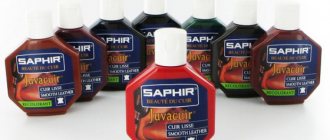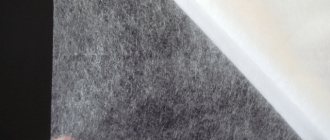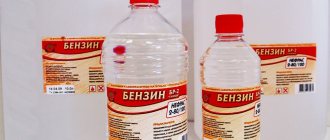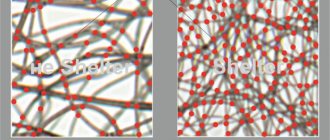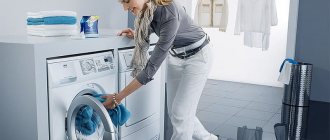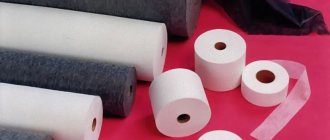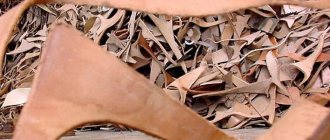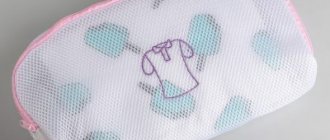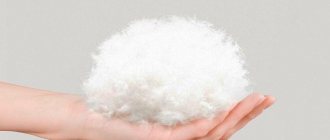Dublerin for fabric - what is it for?
Clothing production is a complex and labor-intensive process. To facilitate work and create new options from various types of fabric and leather, adhesive dublerin was developed - this is a special fabric for shaping the appearance and duplicating the base, which extends the service life and resistance of products to mechanical stress.
A particular example of using a lining is making a collar
Dublerin is common in children's clothing - it is safe and does not emit chemicals.
The main mistakes when duplicating fabric with non-woven fabric
Often, novice craftsmen make mistakes when duplicating cut details, not knowing how to work with non-woven fabric. Also, the occurrence of errors can be affected by vision problems or simple inattention. It is necessary to correct the defect and save the situation in the following cases:
- violation of technology leads to creases and distortions of the gasket;
- an incorrectly selected interlining wrinkles, bubbles, moves away from the fabric and does not fulfill its function;
- errors were made when cutting when there was a discrepancy between the direction of the grain of the main part of the cut and the lining;
- the wrong color of the duplicating material was chosen, which is visible through the fabric and spoils its aesthetic appearance.
You can also accidentally make mistakes when duplicating by mixing up the cut details or gluing the interlining to the front side. The easiest way is to cut out new parts, but it often happens that there is not enough fabric, and you have to remove the interlining in every possible way. You should not tear off the duplicating material without carrying out any actions first, because this way you can damage the fabric and the part will be completely damaged.
How to tidy up your car
You can wash off adhesive tape stains on any component parts of the car, including plastic panels, using almost any of the methods discussed above. However, there is one caveat - when washing a car, it is strictly forbidden to use any type of solvent, including nail polish remover. The fact is that the active toxic substances included in the dissolving liquids can damage the paintwork. As a result, the car owner will get rid of the sticky stain, but will have additional problems in the form of painting the damaged surface of the car.
Tricks and tips for working with elastic duplicating materials
Thin elastic cushioning materials on a woven basis - how to work with them to minimize the risk of errors.
Elastic adhesive materials are good because, while strengthening the base material, they retain its plasticity. But working with such materials is not always easy precisely because of their mobility. During the gluing process, they tend to shift and stick in the wrong way.
You can read the most important rules for choosing adhesive materials and working with them in this large and detailed review:
Sewing school: duplicating clothing parts
The tricks and tips below are for working with elastic duplicating material on a woven basis, especially thin ones.
Why do iron marks appear when ironing and how to avoid this?
So, the procedure + tricks and tips:
Step 1: Secure your work surface
To protect the ironing board from accidental sticking of adhesive material to it, cover the surface of the ironing board with an ironing iron, for example, a piece of chintz or calico.
Step 2. Fix the duplicate material
Place the piece cut from dublin on the piece made from the main fabric, align and cover with an ironing iron. There is no need to iron in the usual sense, by running an iron: the plastic thin dublerin can shift and stick incorrectly or fall into folds. To avoid this, we iron the duplicating material in sections, lowering the iron exactly from above and raising it after a second or two.
Step 3. We finally fix the duplicate material
To securely fix the dublerin on the surface of the part, iron it again, also through an ironing iron. Move the iron in a walking motion, holding it on the surface for 8-10 seconds in each area and lightly pressing the iron. Allow the duplicated parts to cool for 15-20 minutes.
Read recommendations for working with different types of adhesive pads on woven and non-woven bases (iron temperature, exposure time, etc.) here:
Non-woven gasket table
Step 4. The adhesive didn’t stick - what should I do?
Now check if the material has stuck well. Sometimes it doesn't stick properly on the first try.
- First try increasing the pressure on the iron. If after checking the cooled part it turns out that it did not work, then...
- Increase the exposure time - hold the iron on each area not for 8-10 seconds, but 2-4 seconds longer.
Check the duplication quality only on cooled parts.
The reason that the material does not stick after several attempts may be that it is not of good enough quality. In these cases, it is worth replacing the material.
Photo: Natalya Pykhova, thelaststitch.com, amazon. de
Ironing correctly means sewing well!
What is a glue web and why is it needed?
Non-woven tape for clothing is necessary for gluing parts. Cobwebs are sold in rolls, the price is not at all high. One roll will last for a long time. In the 90s of the 20th century, they did not skimp on hidden seams and stitching overlocks. Gossamer does the same thing, just with glue, and is much cheaper.
What does the material look like?
Of course, instead of gossamer or overlock, you can make a regular shuttle stitch.
How to clean web tape from trousers?
Dad hemmed his trousers with the help of this tape, without cutting off the excess length. I want to hem him in a normal way, but I tried how to clean the traces of this cobweb tape (which is glued with an iron) from the trousers, because with each ironing it will stick together (or rather, the trouser leg.) iron it onto the paper - the paper sticks in places and does not come off.
If you wash off the remaining paper with water, the glue still remains. Dad hemmed his trousers with the help of this tape, without cutting off the excess length. I want to hem him in a normal way, but I tried how to clean the traces of this cobweb tape (which is glued with an iron) from the trousers, because with each ironing it will stick together (or rather, the trouser leg.) iron it onto the paper - the paper sticks in places and does not come off. If you wash off the remaining paper with water, the glue still remains.
If suddenly such a nuisance happens, and you desperately need to remove something that has already been tightly glued, then it doesn’t matter!
— Steam with steam from the iron (without leaning the surface of the iron against the fabric) the place where you want to remove the cobwebs. — Then separate the glued layers of fabric. - Carefully pull off the cobwebs.
If not, then take some fabric and put it between the layers where the cobweb was. Iron with a steam iron. Then pull out that fabric - the remaining glue should remain on it.
Whether the glue completely leaves the fabric or not depends on the fabric.
If all this does not help, then there is one remedy with which you can remove everything without a trace!
Glue can be removed using ordinary alcohol. Just rub it over the cobwebs and they will go away.
Why does dublerin not stick to fabric?
When used at home, there is a high risk of error, since the instructions may already be designed for an experienced user who knows exactly what dublerin is and what it is used for.
Therefore, we will consider the main reasons why the adhesive layer of the lining or the base itself may be damaged:
- The most common mistake is gluing without wetting. Any fabric must be wetted before cutting so that the fibers become elastic and cut exactly where needed. You can wet it completely or spray it with a spray bottle.
- Take seam allowances into account - this will allow the lining to be placed freely on the fabric without tension and to avoid deformation.
- During the gluing process, you need to use an ironing iron - traces of glue may come through the lining and stain the surface of the iron.
- The heating of the iron should not exceed the temperature recommended for the fabric.
The most important thing is to glue the dublerin onto the fabric correctly, because many adhesives cannot be cleaned without destroying the base.
Useful tips
- When steaming, you must choose a mode suitable for the fabric. This will avoid damage to the product.
- After removing the tape, the trousers must be washed.
- Solvent, nail polish remover or isopropanol are suitable as a cleaning agent.
- When removing tape with any liquid, it is not recommended to apply a cotton pad to the fabric for a long time in one place. This may cause damage to your trousers.
- The tape can be removed with an iron. We place a piece of unnecessary material on the location of the cobwebs and iron it with the hot platform of an iron with a steam function. After some time, the adhesive base will remain on the underlying material.
- The duration of the removal process and effectiveness largely depend on the texture of the fabric of the product itself.
How to remove interlining from fabric after embroidery
lena.gorunPlease tell me, after embroidering on a tear-off stabilizer, how should it be removed - pick it out from under all the lines or just cut it along the edge of the design? for example when embroidering on a T-shirt?
If this is a real tear-off embroidery interlining and the edge of the embroidery is quite dense, then the interlining can be torn off along the edge with a sharp movement of the hand. well, like wax strips for hair removal. A sewing tear-off that tears in one direction will have to be cut with scissors, because... If it breaks, both the embroidery and the product may be damaged. In some cases, the interlining can be slightly moistened by sprinkling with water and torn off before removal.
Yes, this is an embroidery tear-off stub. I'm interested in how it is removed - completely from all the lines or just along the contour of the design, but remains inside? For example, yesterday I embroidered a ballerina from Alina, there were so many contour lines, I started removing the inside of them, the work is painstaking, it’s not easy to clear the stub everywhere, in one place the line simply burst, although I tried to carefully pull it out, maybe in this case it was just necessary to just stab cut along the contour and leave the inside?
I use water-soluble flezilin for such designs, I don’t like it when the paper remains on the wrong side, it doesn’t come off even after many washes, and sitting and picking it out is not worth the trouble.
October 10, 2019
We decided to personally check the methods for removing “cobwebs” from fabric described on the Internet. Results and conclusions are in the master class.
“Gossamer” or adhesive tape/edge is a non-woven adhesive material that is used to join parts together. For example, when hemming the bottom of trousers, when connecting parts of a collar or cuff, hem and hem, and so on. Gluing the “web” is simple: we lay it between the parts and iron it. But how to remove already glued cobwebs, if there is such a need? We have collected popular tips on this topic and tested them.
Types of web tape for gluing fabric
There are 4 types of fastening tapes:
- Adhesive web on paper base. One side of the tape is covered with a protective layer of paper. Used to create appliqués and patches. The adhesive side is attached to the patch and cut along the contour, after which the paper covering is peeled off, and then the patch is glued to the product.
- Thread stitching technological. It has elasticity and prevents seams from stretching due to stitching in its own coating.
- Non-woven tape for hems. The adhesive sides do not have a protective layer. It is attached in 1 step: the tape is placed between the hem and the fabric of the part, after which this place is subjected to heat treatment, and the 2 parts are fastened together.
- Thread stitching on the bias. Used to strengthen the rounded edges of parts and prevent their deformation during wear and washing.
Kinds
Depending on the tasks and scope of use, there are 3 main types of lining:
- Elastic – often used for casual wear. Pliable, pleasant material, does not wrinkle and retains its shape after dry cleaning.
- Pile – dense adhesive duplicating material. It is used in outerwear, soft toys, and sometimes in the inside of shoes.
- Fabric - the density of dublerin in this version is high. It is used for clothing, shoes and accessories that are subject to mechanical stress.
Which side to glue the dublerin to the fabric
For home use, an adhesive lining can be purchased at a sewing store - be sure to buy the option specifically for your needs, so as not to overpay and spoil the item.
You need to use elastic dublerin according to the following instructions.
To properly glue the dublerin onto the fabric, determine the adhesive side - it will be rough to the touch. This side of the fabric is applied to the wrong side of the garment.
After this, we prepare the tool - the iron must be turned on in the mode for ironing wool or synthetics, and the steam must be turned off. Dublerin for adhesive leather will have to be glued with a special form.
After this, lay the fabric on the ironing board. To use dublerin, you need to moisten it with water from a spray bottle. After this, you can attach the material to the product. After this, you need to glue the dublerin onto the fabric with an iron.
It is important not to iron the material, but rather to press it and warm it for a few seconds
After this, we leave everything for 10–15 minutes to properly glue the fabric with dublerin.
How to replace dublerin at home
In addition to the original dublirin material, you can also use improvised means and analogues. So, instead, you can buy a more affordable non-woven fabric with an adhesive layer - this is a cellulose fabric with good strength. In addition, the original can be replaced with calico or cardboard.
To fix posts, cuffs and collars, the listed materials are used even on an industrial scale. But paper-like analogues have a big disadvantage - unlike the original, they are not elastic and collapse. However, in the case of racks this becomes an advantage.
You can also duplicate the fabric using the glueless method - after steam treatment, organza acquires sufficient density
Considering the possible disadvantages and poor bending resistance of paper counterparts, fabric dublerin remains the best option for giving products a stable shape that will not disappear after washing, ironing, etc.
